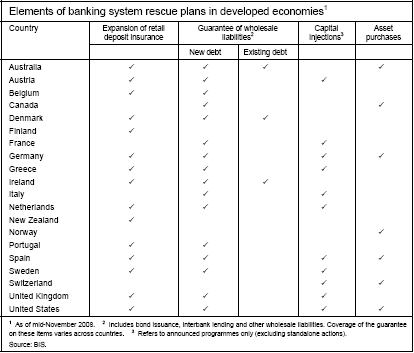Government-led bank rescue initiatives
(Extract from pages 10-11 of BIS Quarterly Review, December 2008)
Government initiatives to strengthen bank balance sheets have evolved from a case by case approach to system-wide intervention. Until September, governments injected capital into individual institutions to avoid their failure and facilitate mergers. This strategy essentially rested on the premise that massive support through liquidity operations by central banks would at some point encourage other banks to lend to each other. As this could not prevent the rapid erosion of market confidence, governments in virtually all advanced economies announced more comprehensive initiatives to stabilise banking systems in late September and early October.
The government initiatives tackled the crisis of confidence on two fronts: one set of measures aimed at ensuring bank funding through explicit government guarantees on retail deposits and other bank liabilities; another set aimed at reducing bank leverage through government purchases of distressed assets or capital injections (see the table).
The announcement of government programmes had a strong signalling effect. Bank CDS spreads fell and funding market conditions stabilised. However, programmes are being modified as the crisis evolves, and details still need to be spelled out in many cases. As a consequence, the impact of government measures on competition and incentives in the financial industry remains uncertain, and whether these measures are sufficient to restart financial intermediation in the broader economy is yet to be seen.
Elements of government programmes announced in September and October
Expansion of retail deposit insurance. Guaranteeing retail bank deposits has been widely used to ensure continued access to deposit funding. The amounts covered by the deposit guarantee schemes have varied substantially across countries, with some extending a blanket guarantee of retail deposits.
Guarantee of wholesale liabilities. To address the drying-up of the wholesale funding market, many governments have announced state guarantees on bank wholesale debt. The range of liabilities covered and fee structures vary widely across countries, with some charging a flat fee and others linking fees to bank CDS spreads.
Capital injections. Direct capital injections have been the main mechanism used to directly support balance sheets. Cross-country differences in instruments and conditions of capital injections have also been considerable. For instance, dividend payments on government preferred shares ranges from 5 to 12.5%. Moreover, some countries impose restrictions on executive compensation and/or dividend payments to common shareholders.
Asset purchases. While removing distressed assets from bank balance sheets is part of several programmes, it has not yet been used on a substantive scale. One issue is determining the price at which the government purchases distressed assets. A substantial support to bank balance sheets may require a purchase price close to par - which may effectively amount to a covert recapitalisation. Moreover, the range of eligible assets might have to cover all distressed credit instruments to have a strong and immediate impact on market confidence. This would require large programmes.
Side effects of government intervention
Impact on broader credit markets. Government guarantees affect the relative price of credit. An extension of the pool of government-guaranteed debt may, other things equal, increase the relative cost of borrowing for debt instruments that are close substitutes for bank debt. For instance, the increase in the spreads of GSE debt in early October could be attributable to this effect. Moreover, the combination of different government actions may complicate assessing and pricing the relative credit risk of various forms of bank liabilities. With capital injections, governments typically take junior positions in the capital structure of banks. This may be interpreted as an implicit state guarantee on all existing liabilities. While the stabilisation benefits of government guarantees are likely to outweigh the costs associated with such market distortions in the near term, a clear exit strategy appears important to limit adverse effects on credit markets in the medium term.
Cross-border issues. While rescue plans follow common principles, national differences in their concrete design and practical implementation are considerable. Differences in the scope and price of government guarantee schemes for new debt issuance may put banks in different jurisdictions at a disadvantage in wholesale funding markets as funding costs will become a function of the specific insurance fee structure and of the solvency of the country that provides the guarantee of bank liabilities. In the extreme case, sovereign risk may be used as a proxy to assess the credit risk of bank debt. Another issue concerns retail deposits in foreign-owned banks, for in many cases there is little clarity about how foreign depositors would be treated in the event of bank failure. The instrument choice and terms for capital injection may also affect competitive positions in global markets. One aspect is differences in the effective cost of capital provided by governments. Another is that the terms of capital injections, and the associated conditions, may affect access to private equity capital.


